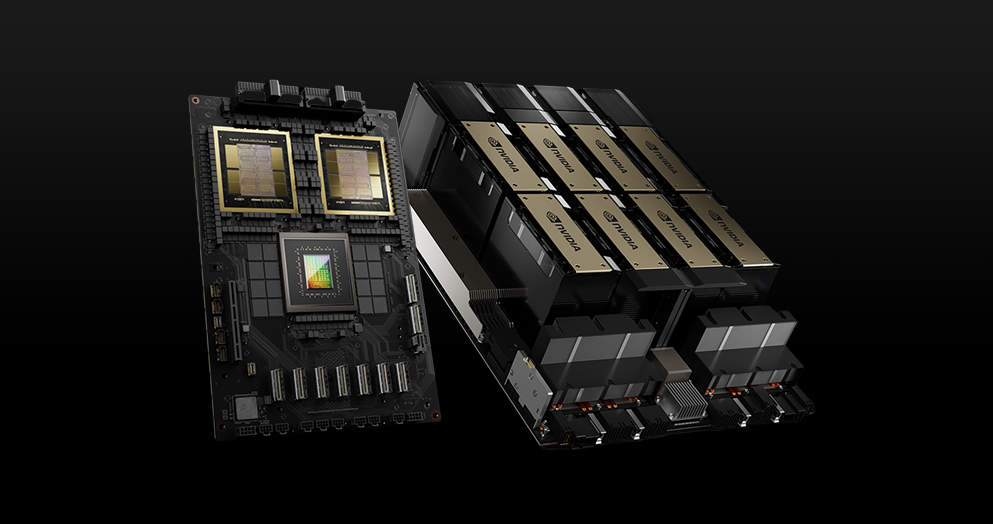Table of contents
In our blog, we will discuss the key differences between NVIDIA Hopper and Blackwell architectures, comparing their performance, features, and suitability for AI and HPC workloads. NVIDIA Hopper, launched in 2022, introduced powerful AI capabilities with 80 billion transistors and HBM3 memory, excelling in LLMs and scientific computing. Blackwell, released in 2024, delivers a massive leap with 208 billion transistors, second-gen Transformer Engine, and 10 TB/s interconnect, making it ideal for generative AI and large-scale simulations. We’ll explore how these architectures impact AI acceleration and real-world applications.
"We created a processor for the generative AI era," said NVIDIA’s CEO Jensen Huang at GTC 2024, as he announced the highly anticipated NVIDIA Blackwell chip. This announcement broke records in the AI space. Designed to meet the demands of the most complex AI models and data-intensive workloads, Blackwell delivers a 2.5x performance boost over its previous-gen architecture NVIDIA Hopper.
While NVIDIA’s Hopper architecture set a new standard for AI and accelerated computing in 2022, Blackwell takes things to another level. But what makes each of these architectures unique and how do they stack up against each other? In this blog, we’ll explore the key differences between NVIDIA Hopper and Blackwell, and which is best suited for your AI and HPC projects.
NVIDIA Hopper vs Blackwell: Key Features
The table below shows the NVIDIA Hopper vs NVIDIA Blackwell specs:
|
Feature |
NVIDIA Hopper Architecture |
NVIDIA Blackwell Architecture |
|
Transistor Count |
80 billion transistors |
208 billion transistors |
|
Manufacturing Process |
TSMC 4N process |
Custom-built TSMC 4NP process |
|
Transformer Engine |
First-generation |
Second-generation |
|
Decompression Engine |
No |
Yes
|
|
Energy Efficiency |
Improved over the previous generation |
25x more energy-efficient than Hopper |
|
Interconnect Technology |
Fourth-generation NVLink |
Fifth-generation NVLink |
|
Chip-to-Chip Interconnect |
900 GB/s |
10 TB/s |
|
Applications |
Generative AI, LLMs, Data processing, Quantum computing |
Accelerated Computing, AI, LLM |
About NVIDIA Hopper

NVIDIA Hopper was launched in 2022 and named after Grace Hopper, a pioneering computer scientist and U.S. Navy rear admiral who was instrumental in the development of computer programming languages. The NVIDIA Hopper architecture excels in tasks like transformer-based AI models, large-scale language models (LLMs), and scientific computing. With 80 billion transistors and HBM3 memory, the H100 GPU offers up to 4 petaflops of AI performance, making it ideal for enterprises and research institutions working on AI, large-scale data centres, and scientific simulations. Hopper’s Transformer Engine is key for accelerating tensor operations, essential for deep learning tasks.
Beyond performance, Hopper also introduced Confidential Computing capabilities, which offer enhanced data security, allowing enterprises to protect sensitive information while performing complex computations.
About NVIDIA Blackwell

NVIDIA Blackwell was released in 2024 and named after David Harold Blackwell, a renowned statistician and mathematician whose work in probability theory and dynamic programming has had a lasting impact on computational sciences. Blackwell’s contributions to the field of mathematical statistics align with the architecture’s focus on generative AI, LLMs, and data-centric workloads.
The NVIDIA GB200 GPU from the Blackwell series boasts 208 billion transistors and HBM3e memory, offering a massive leap in performance compared to the Hopper series. With up to 20 petaflops of AI performance, Blackwell is designed to handle the most demanding computational tasks, such as training large AI models, running complex simulations, and accelerating generative AI applications.
One of Blackwell's standout features is its dedicated decompression engine, which speeds up data processing by up to 800 GB/s—making it 6x faster than Hopper when dealing with large datasets. Blackwell also enhances Confidential Computing, ensuring a secure and efficient environment for sensitive AI workloads, while introducing breakthroughs in quantum simulations and scientific research, making it the next frontier in AI and HPC computing.
NVIDIA Hopper vs Blackwell: Performance Comparison
The performance of NVIDIA Hopper architecture and Blackwell benchmarks shows the significant advancements each architecture brings to cater to different aspects of AI and high-performance computing (HPC).
NVIDIA Hopper Series H100
The NVIDIA H100 Tensor Core GPU is a powerhouse for AI inference, training, and accelerated computing. Leveraging innovations from the Hopper architecture, the H100 is equipped with 80 billion transistors and HBM3 memory, delivering breakthrough performance and scalability for AI models, HPC tasks, and enterprise data centres. The H100 features a Transformer Engine with FP8 precision, offering up to 4x faster training compared to previous generations for large models like Llama 3.
Key capabilities of the NVIDIA Hopper Series H100 GPU include:
- Up to 60 teraflops of FP64 computing for HPC applications.
- 188GB HBM3 memory with high bandwidth for efficient processing of large datasets.
- NVIDIA NVLink provides 900 GB/s bidirectional throughput, making multi-GPU scaling across servers seamless.
The NVIDIA H100 GPUs are designed to supercharge large language models (LLMs) like Llama 3, offering up to 5x faster inference compared to the NVIDIA A100 and with enterprise-ready features like NVIDIA Confidential Computing and NVIDIA AI Enterprise software, it simplifies AI deployment with high levels of security, scalability, and manageability.
NVIDIA Blackwell Series GB200
The NVIDIA Blackwell GB200 NVL/72 36 GPU shows a major leap in generative AI and accelerated computing. Built using 208 billion transistors and featuring HBM3e memory, the NVIDIA GB200 NVL/72 36 provides massive computational power for AI training, inference, and large-scale simulations.
Key NVIDIA Blackwell features of NVIDIA GB200 NVL/72 36 include:
- Second-generation Transformer Engine with new micro-tensor scaling techniques for FP4 precision, doubling the performance of next-gen AI models while maintaining high accuracy.
- 10 TB/s chip-to-chip interconnect, enabling faster data communication within multi-die GPUs for enhanced generative AI processing.
- NVIDIA Decompression Engine, delivering up to 900 GB/s bandwidth, significantly accelerating data processing for large datasets and analytics workloads.
- Confidential Computing capabilities, protecting sensitive AI models with hardware-based security and TEE-I/O integration.
With up to 20 petaflops of AI performance, Blackwell is ideal for generative AI models, LLMs, and high-performance scientific computing.
NVIDIA Hopper vs Blackwell GPU: Products

As an official NVIDIA NCP Partner, we integrate the latest NVIDIA technologies with flexible configuration options so you can scale your AI and HPC projects. At AI Supercloud, we offer the following cutting-edge hardware:
Hopper Series
How to Access NVIDIA Hopper GPUs
The NVIDIA Hopper series, including the NVIDIA HGX H100 and NVIDIA HGX H200, are available on the AI Supercloud for deployment. These GPUs are designed for high-performance AI and accelerated computing workloads, offering industry-leading capabilities for tasks like large language model (LLM) inference, HPC, and enterprise AI solutions.
You can reserve the NVIDIA HGX H100 or NVIDIA HGX H200 and take advantage of our customised solutions tailored to your workload requirements. With fully managed services, on-demand scalability, and MLOps support, the AI Supercloud is optimized to help you deploy your AI projects faster and more efficiently.
Book a call today to explore how NVIDIA Hopper GPUs can accelerate your AI and HPC tasks, and to discuss custom configurations for your specific needs.
Blackwell Series
When are NVIDIA Blackwell GPUs Coming Out?
The highly anticipated NVIDIA Blackwell chip GB200 NVL72/36 is expected to be available by the end of 2025. These cutting-edge GPUs are designed to deliver exceptional performance for AI and high-performance computing (HPC) workloads. We are one of the first Elite Cloud Partners in the NVIDIA Partner Network to offer NVIDIA Blackwell platform-powered compute services. You can reserve the NVIDIA GB200 NVL72/36 in advance on the AI Supercloud and secure early access to the fastest performance for your AI projects. By reserving now, you’ll be among the first to leverage Blackwell’s unmatched capabilities in generative AI and large-scale model training.
Book a call today to discuss how our bespoke solutions and managed services for NVIDIA GB200 NVL72/36 can help take your AI initiatives to the next level.
FAQs
Is Blackwell faster than Hopper?
Yes, NVIDIA Blackwell is up to 2.5 times faster than Hopper, offering a performance boost through advancements like the second-generation Transformer Engine, a decompression engine and a much faster chip-to-chip interconnect speed.
What Hopper GPUs does the AI Supercloud offer?
The NVIDIA Hopper series, including the NVIDIA HGX H100 and NVIDIA HGX H200, are available on the AI Supercloud for deployment. Schedule a call with our solutions engineer today to explore how NVIDIA Hopper GPUs can accelerate your AI and HPC tasks and to discuss custom configurations for your specific needs.
What is the difference between NVIDIA H100 and NVIDIA GB200?
The NVIDIA H100 features 80 billion transistors, HBM3 memory and excels in AI inference and HPC with up to 4 petaflops of AI performance. While the NVIDIA GB200 NVL72 offers 208 billion transistors, HBM3e memory and a 2.5x performance boost with up to 20 petaflops, ideal for generative AI and large-scale model training.
What is special about NVIDIA Blackwell?
NVIDIA Blackwell features 208 billion transistors, HBM3e memory, a second-generation Transformer Engine, and a decompression engine for ultra-fast data processing. Its 10 TB/s chip-to-chip interconnect and enhanced Confidential Computing make it ideal for generative AI, large-scale models, and HPC workloads.
When are NVIDIA Blackwell GPUs Coming Out?
NVIDIA Blackwell GPUs such as the NVIDIA GB200 NVL72/36, are expected to be available by the end of 2025. Early access reservations are available through AI Supercloud for those wanting to leverage its cutting-edge capabilities in generative AI and HPC.


